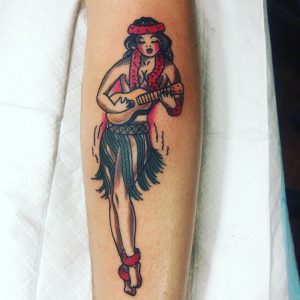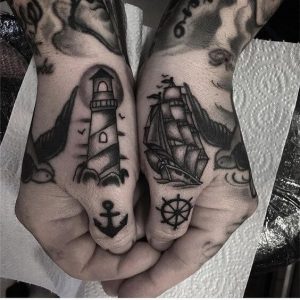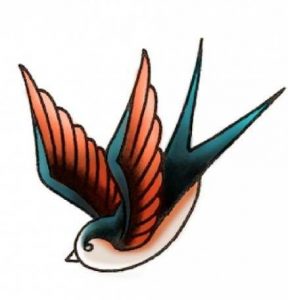Old School Sailor Tattoos II
Follow along as we keep diving into the rich and fascinating traditions of the tattoos of seafarers far and wide. The more they sailed, the more they earned. Gunpowder for ink and the original knuckle phrase tattoo that could make the difference between life and death… as if sailing the seven seas wasn’t badass enough.
Dice and Harpoons
A set of dice would indicate that the wearer was somewhat of a fearless risk-taker, and enjoyed a bit of a gamble. If the sailor sported a harpoon, it would mean that he had belonged to a fishing fleet, most likely one specialising in whaling.
HOLD FAST
The original knuckle-phrase tattoo, HOLD FAST, was to symbolise that a sailor should never, ever let go  of the ropes. Holding the rudder, ropes and boat fast in times of bad and stormy weather could mean the difference between life and death to everyone involved. You’d definitely want a sailor onboard who was true to those words.
of the ropes. Holding the rudder, ropes and boat fast in times of bad and stormy weather could mean the difference between life and death to everyone involved. You’d definitely want a sailor onboard who was true to those words.
Pin-ups, hulas and mermaids
Many sailors would get a pin-up style tattoo of an idealised woman to keep him company while at sea. A classic pin-up girl was to remind him of the love he left at the shore. Mermaids, on the other hand, symbolised a sailor’s love for the sea, sometimes treacherous though she may be. If a sailor had been stationed in Hawaii, he would get the image of a hula girl.
Light in the dark
A lighthouse is a literal representation of a guiding light, what seafarers look to show them the way to the shore when they are in darkness and need. It may also have been a description of faith in God for those sailors with a religious inclination.
Animal talismans
Pigs, chickens and roosters were popular as talismans for surviving potential shipwrecks. Not exactly Olympic style swimmers, these animals were kept in wooden crates on the deck of the ship. If the boat went under, they would be aided by the crates, float, and later washed ashore still alive in their boxes.
Turtles for the equator
Shellback turtles also represented a sailor’s experience at sea. The particular creature symbolises that its wearer has crossed the equator. A tattoo of King Neptune is taken to mean the same.
Swallows for range and memorials
One of the most prolific tattoos in sailor culture is that of the swallow. It became a popular representation  of their mutual characteristic of returning home after a long journey. The bird is also often the first living creature a sailor sees when close to land. Each swallow a sailor would get tattooed represented 5,000 nautical miles of traversing the seas. If a swallow is depicted with a dagger through its chest, it is done in the honour of a fallen shipmate.
of their mutual characteristic of returning home after a long journey. The bird is also often the first living creature a sailor sees when close to land. Each swallow a sailor would get tattooed represented 5,000 nautical miles of traversing the seas. If a swallow is depicted with a dagger through its chest, it is done in the honour of a fallen shipmate.
Gunpowder ink
The indigenous tribes from which sailors first picked up the habit often used ash diluted with water to make their dye. The sailors themselves used gunpowder. Legend had it that it possessed some type of mystical powers of protection, which made it a popular ingredient in nautical ink.
As you can see from the list in this post and the last, the more time a sailor spent at sea, the more tattoos he had the right to ink on his body. They served as a kind of logbook, detailing adventures, achievements, rank and stationing. Along with the expressions of love, be that for a sweetheart or the sea, and superstitious forms of protection, they have come to form the basis for modern tattooing. If you have ink on your body, you are part of a long-standing, seafaring tradition. Even if you are just a bit of a landlubber.
